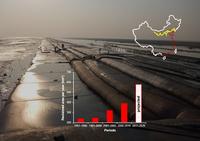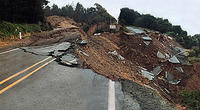-
Court: San Diego infrastructure, mass transportation plans fail to meet climate tests
Two lawsuits by environmental groups including the Sierra Club, the Cleveland National Forest Foundation, and the Center for Biological Diversity, against the San Diego County government and the San Diego Association of Governments (SANDAG) could force the region to rethink how it plans to spend billions of dollars in the next few decades on infrastructure and mass transportation projects.
-
-
Reducing the impact of extreme weather
How do we reduce the impact of extreme weather today while preparing ourselves for future changes? What can we do to build our resilience? A new report from the Royal Society investigates these, and other, key questions to help inform important decisions about adaptation and risk reduction that are being made at global, national and local levels.
-
-
New report highlights “significant and increasing” risks from extreme weather

A comprehensive new report, published by the Royal Society, indicates that exposure of human populations to extreme weather is set to increase as global climate and population size, location, and age continue to change. The report focuses on the risks to people from floods, droughts, and heatwaves. These are some of the most frequent and damaging extreme events that currently occur and their impacts will change with the changing climate. The report also calls for changes to global financial accounting and regulation to ensure that extreme weather risk is made explicit. At present, these risks are not systematically factored into investors’ valuations or assessed by creditors.
-
-
San Francisco to add local groundwater to reservoir supply
The San Francisco Public Utilities Commission has begun digging in the area around Golden Gate Park with the intention of adding local underground water flows to the traditionally sourced water from the Hetch Hetchy Reservoir in Yosemite. The change is expected to take place over the next two years and will replace between 10 to 15 percent of the water supply. Despite the fact that the water is less pure, city officials expect that difference will be negligible.
-
-
California’s early-warning ShakeAlert system to be rolled out next year
Officials in California expect the state’s ShakeAlertsystem to be available to some schools, fire stations, and more private companies early next year. Until now, only earthquake researchers, some government agencies, and a few private firms have received alerts from the statewide earthquake early warning system. The 2015 expansion will occur as long as Congress approves a $5 million funding request that has passed committees in both the Senate and House. A full vote on the budget was delayed until after the midterm elections.
-
-
Resilience of California’s transportation infrastructure questioned
A significant number of bridges and elevated roadways lie above or close to active fault lines, and Californians often wonder how the state’s towering interchanges and freeway network would perform during a major earthquake.The California Department of Transportation (Caltrans) has spent over $13 billion in the last forty years to reinforce vulnerable bridges and interchanges. Caltrans officials note that during a major earthquake, freeways are likely to sustain significant damage, but engineers feel confident that freeways will not collapse.
-
-
Here’s how to fix America’s crumbling bridges

There are about 600,000 bridges in the United States, and about one in four is classified as functionally obsolete or structurally deficient. This doesn’t mean they’re in danger of imminent collapse; they may be simply too narrow or built for lighter traffic than today’s standards. Bridges that can’t support heavy trucks have weight restrictions posted. There are plenty of repairs that need to be done. With government funding for infrastructure projects being so tight, an alternative has arisen in what are called public-private partnerships, often abbreviated PPP or P3. In this arrangement, private investors assume the responsibility for financing and building a bridge or highway, and the investors are granted the right to collect tolls for what may be decades. The investors naturally believe they will realize a good return on their investment, even after they pay the public partner a sizable sum upfront for the concession. This upfront payment can be in the billions of dollars, which can be very tempting for a state or municipality struggling to balance its budget.
-
-
A malware more sophisticated than Stuxnet discovered
Security experts at Symantechave discovered the world’s most sophisticated computer malware, Regin. Thought to have been created by a Western intelligence agency, and in many respects more advanced than Stuxnet — which was developed by the U.S. and Israeli government in 2010 to hack the Iranian nuclear program — Regin has targeted Russian, Saudi Arabian, Mexican, Irish, and Iranian Internet service providers and telecoms companies. “Nothing else comes close to this … nothing else we look at compares,” said one security expert.
-
-
Iran may resume cyberattacks on U.S. if nuclear deal is not reached
A failure for the United States to reach a nuclear deal with Iran could result in more cyberattacks against U.S. companies, House Intelligence Committeechairman Mike Rogers (R-Michigan) said. Cyberattacks by Tehran declined dramatically after the United States, other permanent members of the Security Council, and Germany agreed to an interim nuclear deal with Iran in 2013, but should the parties fail to reach a permanent nuclear deal by the newly set March 2015 and July 2015 deadlines, financial firms, oil and gas companies, and water filtration systems could be targets of malware from Iran’s cyber army.
-
-
Cyber experts divided over the scope of damage of a cyberattack on U.S.
Citing the risks of lack of preparation against future cyberattacks and the absence of security infrastructure, a new report urges across the board updates in the domain of cybersecurity. Most of the experts interviewed for the report pointed to the Stuxnet malware, which damaged Iranian nuclear-enrichment centrifuges and other nuclear-related machinery in 2010, as an example of the sort of future attacks that could disable and destroy vital infrastructure such as power grids, air-traffic controls, and banking institutions.
-
-
New light shed on reactor fuel behavior during severe nuclear reactor accidents
UO2 is the primary fuel component in the majority of existing nuclear reactors, but little is known about the molten state because of its extremely high melting point. Until now, the extremely high temperature and chemical reactivity of the melt have hindered studies of molten UO2. This lack of fundamental information has made it difficult to evaluate issues associated with the interaction of molten UO2 with a reactor’s zirconium cladding and steel containment vessel. A new discovery about the atomic structure of uranium dioxide will help scientists select the best computational model to simulate severe nuclear reactor accidents.
-
-
NSA director: China and “one or two” other nations can damage U.S. critical infrastructure
Adm. Michael Rogers, director of the National Security Agency and head of U.S. Cyber Command, told lawmakers yesterday that China and “one or two” other countries are capable of mounting cyberattacks which would paralyze the U.S electric grid and other critical infrastructure systems across the country. A cyberattacks of such scope has been discussed in the past – it was even dubbed a “cyber Pearl Harbor” – but Rogers was the first high official to confirm that such a crippling attack on the United States was not a mere speculation. Rogers said U.S. adversaries are conducting electronic “reconnaissance” on a regular basis so that they will be well-positioned to damage and disrupt the industrial control systems which run chemical facilities, nuclear power plants, water treatment facilities, dams, and much more.
-
-
China’s second “great wall” is not so great

China’s coastal regions are only 13 percent of the country’s land area, but contribute 60 percent of its gross domestic product. With that come layers of incentives to turn lush wetlands into engines of development and industry. A new study finds that China’s second great wall, a vast seawall covering more than half of the country’s mainland coastline, is a foundation for financial gain - and also a dyke holding a swelling rush of ecological woes.
-
-
Selling and buying water rights
Trying to sell or buy water rights can be a complicated exercise. First, it takes time and effort for buyers and sellers to find each other, a process that often relies on word-of-mouth, local bulletin boards, even calling friends and neighbors to get the word out. Then they must deal with the maze of rules and regulations involved. Finally, they must reach a fair price. It would be much easier if a computer could do it. Now, one can. Scientists have developed an algorithm that can match potential buyers and sellers, sift through the complexity of local physical and regulatory systems, and reach a fair deal designed especially for them.
-
-
New technology increases awareness of landslide risks

Engineers have created a new way to use lidar technology to identify and classify landslides on a landscape scale, which may revolutionize the understanding of landslides in the United States and reveal them to be far more common and hazardous than often understood. The new, non-subjective technology can analyze and classify the landslide risk in an area of fifty or more square miles in about thirty minutes — a task that previously might have taken an expert several weeks to months. It can also identify risks common to a broad area rather than just an individual site.
-
More headlines
The long view
Helping Strengthen America’s Critical Infrastructure
Everyday life depends on a robust infrastructure network that provides access to running water, communications technology and electricity, among other basic necessities. The experts who keep our national infrastructure secure and resilient also need a strong network to share their knowledge and train the next generation of professionals capable of solving complex infrastructure challenges.
AI and the Future of the U.S. Electric Grid
Despite its age, the U.S. electric grid remains one of the great workhorses of modern life. Whether it can maintain that performance over the next few years may determine how well the U.S. competes in an AI-driven world.
Using Liquid Air for Grid-Scale Energy Storage
New research finds liquid air energy storage could be the lowest-cost option for ensuring a continuous power supply on a future grid dominated by carbon-free but intermittent sources of electricity.
Enhanced Geothermal Systems: A Promising Source of Round-the-Clock Energy
With its capacity to provide 24/7 power, many are warming up to the prospect of geothermal energy. Scientists are currently working to advance human-made reservoirs in Earth’s deep subsurface to stimulate the activity that exists within natural geothermal systems.
Experts Discuss Geothermal Potential
Geothermal energy harnesses the heat from within Earth—the term comes from the Greek words geo (earth) and therme (heat). It is an energy source that has the potential to power all our energy needs for billions of years.
